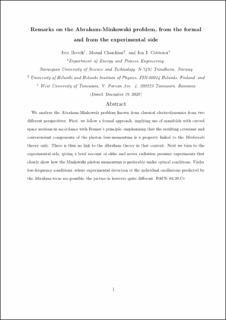| dc.contributor.author | Brevik, Iver Håkon | |
| dc.contributor.author | Chaichian, Masud | |
| dc.contributor.author | Cotaescu, I. I. | |
| dc.date.accessioned | 2021-10-26T07:56:47Z | |
| dc.date.available | 2021-10-26T07:56:47Z | |
| dc.date.created | 2021-02-05T14:51:46Z | |
| dc.date.issued | 2021 | |
| dc.identifier.citation | International Journal of Modern Physics A. 2021, 36, . | en_US |
| dc.identifier.issn | 0217-751X | |
| dc.identifier.uri | https://hdl.handle.net/11250/2825549 | |
| dc.description.abstract | We analyze the Abraham–Minkowski problem known from classical electrodynamics from two different perspectives. First, we follow a formal approach, implying use of manifolds with curved space sections in accordance with Fermat’s principle, emphasizing that the resulting covariant and contravariant components of the photon four-momentum are a property linked to the Minkowski theory only. There is thus no link to the Abraham theory in that context. Next we turn to the experimental side, giving a brief account of older and newer radiation pressure experiments that clearly show how the Minkowski photon momentum is preferable under optical conditions. Under low-frequency conditions, where experimental detection of the individual oscillations predicted by the Abraham term are possible, the picture is however quite different. | en_US |
| dc.language.iso | eng | en_US |
| dc.publisher | World Scientific Publishing | en_US |
| dc.title | Remarks on the Abraham-Minkowski problem, from the formal and from the experimental side | en_US |
| dc.type | Peer reviewed | en_US |
| dc.type | Journal article | en_US |
| dc.description.version | acceptedVersion | en_US |
| dc.source.pagenumber | 10 | en_US |
| dc.source.volume | 36 | en_US |
| dc.source.journal | International Journal of Modern Physics A | en_US |
| dc.identifier.doi | 10.1142/S0217751X21500639 | |
| dc.identifier.cristin | 1887157 | |
| dc.description.localcode | This is the authors' accepted manuscript to an article published by World Scientific Publishing Company | en_US |
| cristin.ispublished | true | |
| cristin.fulltext | postprint | |
| cristin.qualitycode | 1 | |
